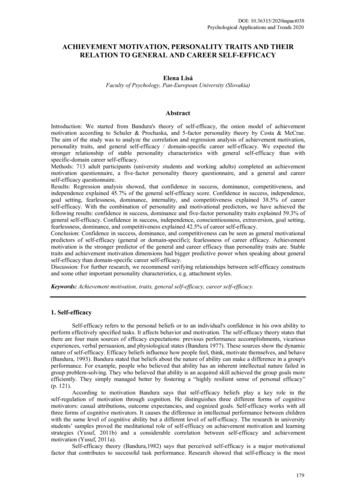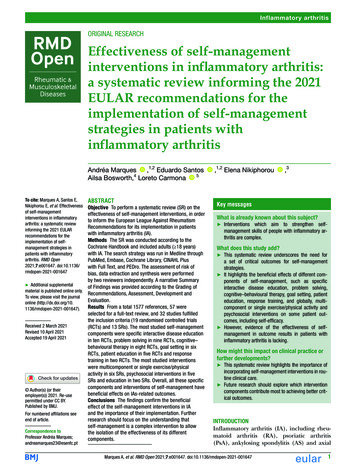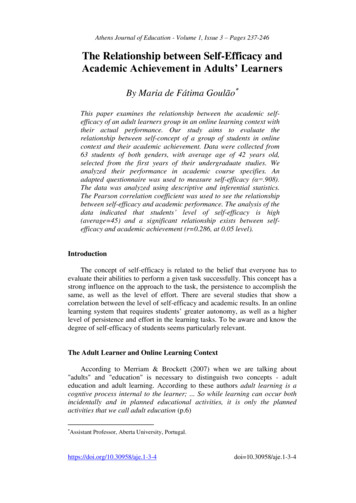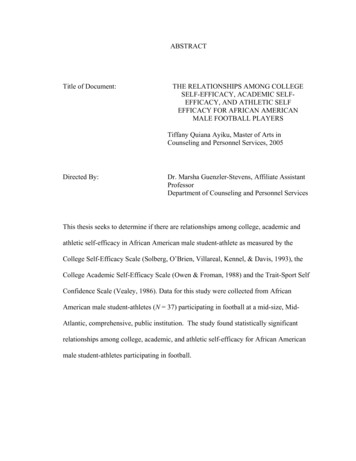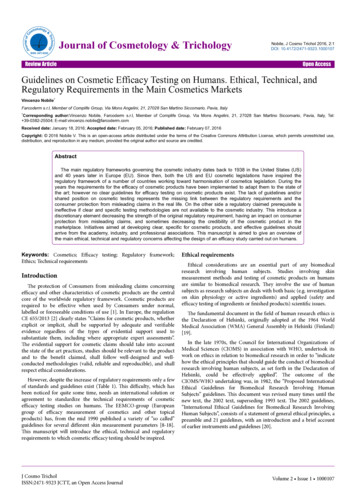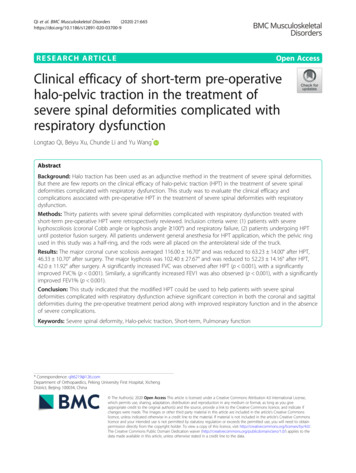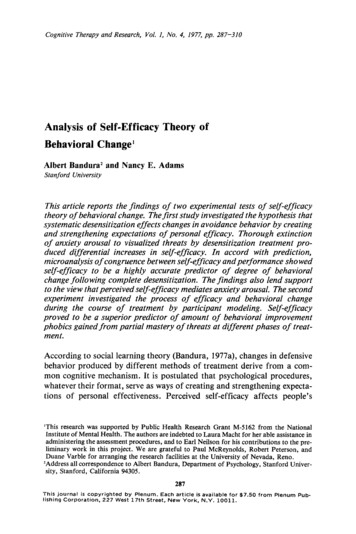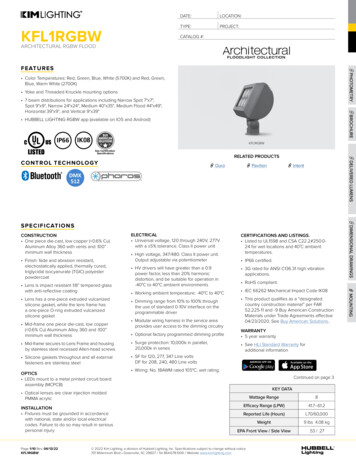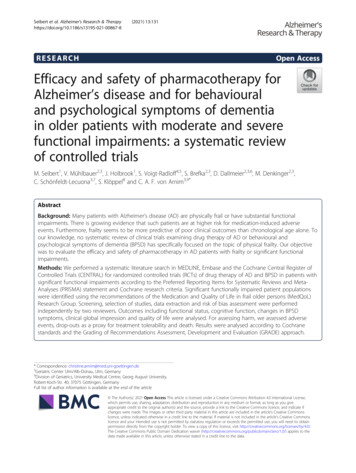
Transcription
Seibert et al. Alzheimer's Research & 2021) 13:131RESEARCHOpen AccessEfficacy and safety of pharmacotherapy forAlzheimer’s disease and for behaviouraland psychological symptoms of dementiain older patients with moderate and severefunctional impairments: a systematic reviewof controlled trialsM. Seibert1, V. Mühlbauer2,3, J. Holbrook1, S. Voigt-Radloff4,5, S. Brefka2,3, D. Dallmeier2,3,6, M. Denkinger2,3,C. Schönfeldt-Lecuona3,7, S. Klöppel8 and C. A. F. von Arnim3,9*AbstractBackground: Many patients with Alzheimer’s disease (AD) are physically frail or have substantial functionalimpairments. There is growing evidence that such patients are at higher risk for medication-induced adverseevents. Furthermore, frailty seems to be more predictive of poor clinical outcomes than chronological age alone. Toour knowledge, no systematic review of clinical trials examining drug therapy of AD or behavioural andpsychological symptoms of dementia (BPSD) has specifically focused on the topic of physical frailty. Our objectivewas to evaluate the efficacy and safety of pharmacotherapy in AD patients with frailty or significant functionalimpairments.Methods: We performed a systematic literature search in MEDLINE, Embase and the Cochrane Central Register ofControlled Trials (CENTRAL) for randomized controlled trials (RCTs) of drug therapy of AD and BPSD in patients withsignificant functional impairments according to the Preferred Reporting Items for Systematic Reviews and MetaAnalyses (PRISMA) statement and Cochrane research criteria. Significant functionally impaired patient populationswere identified using the recommendations of the Medication and Quality of Life in frail older persons (MedQoL)Research Group. Screening, selection of studies, data extraction and risk of bias assessment were performedindependently by two reviewers. Outcomes including functional status, cognitive function, changes in BPSDsymptoms, clinical global impression and quality of life were analysed. For assessing harm, we assessed adverseevents, drop-outs as a proxy for treatment tolerability and death. Results were analysed according to Cochranestandards and the Grading of Recommendations Assessment, Development and Evaluation (GRADE) approach.* Correspondence: christine.arnim@med.uni-goettingen.de3Geriatric Center Ulm/Alb-Donau, Ulm, Germany9Division of Geriatrics, University Medical Centre, Georg August University,Robert-Koch-Str. 40, 37075 Göttingen, GermanyFull list of author information is available at the end of the article The Author(s). 2021 Open Access This article is licensed under a Creative Commons Attribution 4.0 International License,which permits use, sharing, adaptation, distribution and reproduction in any medium or format, as long as you giveappropriate credit to the original author(s) and the source, provide a link to the Creative Commons licence, and indicate ifchanges were made. The images or other third party material in this article are included in the article's Creative Commonslicence, unless indicated otherwise in a credit line to the material. If material is not included in the article's Creative Commonslicence and your intended use is not permitted by statutory regulation or exceeds the permitted use, you will need to obtainpermission directly from the copyright holder. To view a copy of this licence, visit http://creativecommons.org/licenses/by/4.0/.The Creative Commons Public Domain Dedication waiver ) applies to thedata made available in this article, unless otherwise stated in a credit line to the data.
Seibert et al. Alzheimer's Research & Therapy(2021) 13:131Page 2 of 20Results: Of 45,045 search results, 38,447 abstracts and 187 full texts were screened, and finally, 10 RCTs wereincluded in the systematic review. Selected articles evaluated pharmacotherapy with acetylcholinesterase-inhibitors(AChEI), anticonvulsants, antidepressants and antipsychotics. Studies of AChEIs suggested that patients withsignificant functional impairments had slight but significant improvements in cognition and that AChEIs weregenerally well tolerated. Studies of antidepressants did not show significant improvements in depressive symptoms.Antipsychotics and anticonvulsants showed small effects on some BPSD items but also higher rates of adverseevents. However, due to the very small number of identified trials, the quality of evidence for all outcomes was lowto very low.Overall, the small number of eligible studies demonstrates that significantly functional impaired older patients havenot been adequately taken into consideration in most clinical trials investigating drug therapy of AD and BPSD.Conclusion: Due to lack of evidence, it is not possible to give specific recommendations for drug therapy of ADand BSPD in frail older patients or older patients with significant functional impairments. Therefore, clinical trialsfocussing on frail older adults are urgently required. A standardized approach to physical frailty in future clinicalstudies is highly desirable.Keywords: Frail elderly, Alzheimer’s disease, Dementia, BPSD, Systematic review, Drug therapyIntroductionPeople over the age of 75 years are the world’s fastestgrowing demographic group. Health systems worldwidemust meet new challenges generated by the ageingpopulation, including the medical care of frail older patients [1, 2]. With increasing population age, the prevalence of age-associated conditions such as Alzheimer’sdisease (AD) and frailty will also rise [3, 4]. Factors suchas frailty or disability appear to be more predictive fordetrimental outcomes (e.g., mortality) than chronologicalage alone [5–7]. Although the International Council forHarmonisation of Technical Requirements for Pharmaceuticals for Human Use (ICH) recommended the inclusion of frail older patients in RCTs as far back as 1993,these patients are still seldom included in RCTs [8–11].Therefore, although such patients are overrepresented inreal-world clinical settings, as they often have multiplemorbidities and are recipients of polypharmacy, they areunderrepresented in the studies that provide the data onwhich clinical treatments are based [12]. Due to the lackof available evidence, frailty is also often ignored duringthe formulation of medical guidelines [13]. It is wellknown that medications may have different effects inthis vulnerable population: impaired functional status,systemic illness and metabolic changes may result in different pharmacologic and pharmacodynamic responses,a different adverse event profile and ultimately a different risk-benefit calculus [12, 14, 15].Despite its importance as a medical concept, there isstill no clear universally accepted definition of frailty.Frailty is generally described as an age-associated syndrome with increased vulnerability to minor stressorevents because of impairments in multiple systems [16,17]. The concept of frailty takes biological age into account rather than chronological age. Many differentapproaches are used to estimate frailty [18, 19]. The twomost used are the (i) Frailty Phenotype by Fried et al.and the (ii) Frailty Index (FI) by Rockwood and Mitnitski. The so-called Frailty Phenotype mainly applies tophysical frailty, as assessed by reduced grip strength, unintended weight loss, exhaustion, decreased physical activity and slow gait speed [16]. Rockwood and Mitnitskihave proposed defining frailty by an accumulation ofdeficits, including but not limited to functional items,and mainly relying on comorbidities, including cognitiveimpairments [20]. Frailty is however in both conceptstightly linked to functional status. Patients with AD havemore comorbidities and are more often physically frailthan patients without AD [21–23]. Conversely, some evidence indicates that frail older patients may have ahigher risk of developing AD; furthermore, higher frailtyscores are associated with a more rapid cognitive decline[24, 25]. Frailty may also result in a higher risk of adverse events from drug therapy for AD, for instance,during the use of antidementia medications such asacetylcholinesterase inhibitors [14, 26].Frailty of AD patients also correlates with the severity of behavioural and psychological symptoms ofdementia (BPSD, e.g. psychosis, depression, apathy,agitation, aggression and sleep disturbances) andcaregiver burden [27, 28]. Reciprocally, AD patientswith BPSD are more likely to be frail and may alsohave a higher risk for adverse events such as fallsduring drug therapy [29]. Drug therapy of BPSD inpatients with AD is usually recommended only ical interventions are not sufficient [30].BPSD is a substantial consideration in patients withAD and has a major impact on patients’ and caregivers’ quality of life [31, 32]. Common therapies for
Seibert et al. Alzheimer's Research & Therapy(2021) 13:131BPSD often consist of psychopharmacotherapy (e.g.antipsychotics, antidepressants or even anticonvulsants), many of which may have anticholinergicproperties and are possibly inappropriate for geriatricpatients, as indicated in the Beers’ criteria list or thePRISCUS list [33, 34].Despite the broad importance of drug therapy for thetreatment of cognitive and BPSD symptoms in frail ADpatients, to our knowledge, there has been no systematicreview in this population, even though the available literature suggests a different risk-benefit ratio due to ahigher rate of adverse events. Current evidence mainlyrelies on a mere handful of RCTs. The objective of thisreview was to determine the efficacy and safety of drugtherapy for frail older patients with Alzheimer’s diseaseand associated BPSD. Is there sufficient evidence to recommend safe and effective treatments for this vulnerablepatient population?MethodsThe review process was performed according to the Preferred Reporting Items for Systematic Reviews andMeta-Analyses (PRISMA) statement and the CochraneHandbook for Systematic Reviews of Interventions [35,36].Types of studiesWe included double-blind RCTs comparing pharmacotherapy of AD or BPSD in AD with placebo or otherdrug interventions and involving frail older patients.Studies in any settings were included (outpatient, inpatient, long term care facilities or nursing homes).Studies including patients with dementia or with neuropsychiatric symptoms not in the context of AD wereexcluded.Types of participantsThe patients in included trials had to be diagnosedwith AD according to internationally accepted criteriasuch as the Diagnostic and Statistical Manual of Mental Disorders criteria IV and 5 (DSM IV/DSM-5) [37,38], International Classification of Diseases 10 (ICD10) [39] or the National Institute of Neurological andCommunicative Disorders and Stroke-Alzheimer’s Disease and Related Disorders Association (NINCDSADRDA) criteria [40]. Studies were also eligible if ADpatients constituted a major part of the study population ( 50%), even if other types of dementia werealso included. Patient populations with BPSD resultingfrom AD were also considered. A mean age of 70years or more or a minimum age of 65 years wasrequired.Page 3 of 20Physical frailty/functional impairment evaluationTo evaluate physical frailty and/or significant functionalimpairments, the patient population in RCTs was classified according to the Medication and Quality of Life inFrail Older Persons (MedQoL) Research Group criteria,which define cut-offs for 51 established scores and differentiates between functionally independent, functionally slightly impaired, functionally significantly impaired/partially dependent and functionally severely impaired/disabled/mostly or totally dependent [41]. The studypopulation had to be rated on average as at least “significantly impaired or partially dependent” to allow inclusion in this review. However, studies in which frailty wasdefined mainly based on cognitive impairment were excluded, because this could have resulted in AD patientsbeing included only on the basis of their associated cognitive deficits. This was discussed within the MedQoLResearch Group and mutually agreed upon. Using thismethodology, we identified study patient populationsthat were likely to be physically frail or significantlyfunctionally impaired (but not primarily due to cognitivedeficits).Types of interventionsAny pharmacotherapies for AD and BPSD in any dosageor treatment duration were included.Types of outcome measuresThe following outcomes were defined [42]: Functional status as rated by MedQoL criteria [41], Cognitive function (as measured by psychometrictests), Changes in BPSD symptoms (as measured bypsychometric tests or questionnaires), Clinical global impression, and Quality of life.For assessing harm, we determined the outcomes: Adverse events, Drop-outs as a proxy for treatment tolerability, and Death.These outcomes correspond to the AD-recommendedoutcomes for AD trials by the IQWiG (Institute forQuality and Efficiency in Health Care) and the EMA(European Medicines Agency) [43, 44].Search methods for identification of studiesWe searched the following databases: Embase, MEDLINE and the Cochrane Central Register of ControlledTrials (CENTRAL), on 24/06/2017. There was no restriction on publication language. An update search was
Seibert et al. Alzheimer's Research & Therapy(2021) 13:131performed on 15/01/2019. We defined 1 January 1992 asthe publication period’s lower limit, as it was about thetime of the introduction of the term “frailty” in currentliterature [45].In addition, the German national guidelines for therapy of AD and BPSD and the references from systematicreviews were also screened for relevant studies. All identified publications were imported in Covidence1 [46] andthen independently screened by two reviewers (VM,MS). If the authors disagreed on a study’s inclusion, discussion was continued until consensus was reached;otherwise, a third review author (CvA) was consulted.Data extraction and risk of bias assessmentData were independently extracted by two review authors (VM, MS) using a standardized data collectionform by the Cochrane Effective Practice and Organisation of Care (EPOC) group [47]. Whenever data werenot reported or were not suitable for extraction the corresponding author was contacted. Missing standard deviations (SD) were calculated using other reportedstatistical data.The risk of bias assessment was performed independently by two review authors (VM, MS) using theCochrane Collaboration’s tool for assessing risk of biasin RCTs [48].For each publication, the risk of bias was rated as high,low or unclear. If authors disagreed, discussion was continued until consensus was reached; otherwise, a thirdreview author (CvA) was consulted.Data analysisWe calculated mean differences (MD) or standardizedmean differences (SMD) for continuous outcomes or therisk ratio (RR) for dichotomous outcomes, and the corresponding 95% confidence interval (CIs) using a fixedeffect model. A probability value of 0.05 was determined to be the significance level.Heterogeneity was assessed using the I2 test. For probably relevant heterogeneity (I2 value 50%), possiblecauses were examined, and a random-effect model wasused.We analysed shorter ordinal scores such as the ClinicalGlobal Impression - Improvement Scale (CGI-I, a 7point Likert scale) as dichotomous outcomes by combining adjacent categories into two groups: “worsening/nochange” or “clinical improvement”.When analysing outcomes of cross-over trials, potentially relevant carry-over effects or other issues regardingthe cross-over study design were handled by only including study data of the first treatment period.1Covidence is the primary screening and data extraction tool forCochrane authors.Page 4 of 20The statistical analysis was performed using ReviewManager 5.3 (RevMan) by the Cochrane Collaboration(MS) [49].Quality of evidence ratingsQuality of evidence was assessed using the Grading ofRecommendations Assessment, Development and Evaluation (GRADE) approach [50, 51]. GRADE ratings wereperformed by two review authors independently (VM,MS) according to recommendations of the GRADEhandbook [52].Using the GRADE approach, quality of evidence (verylow/low/moderate/high) for most important outcomesare rated separately using the following explicit criteria:study design, risk of bias, imprecision, inconsistency, indirectness and magnitude of effect. The following outcome groups were considered as most important andincluded in GRADE ratings: functional status, cognitivefunction, BPSD, adverse events, treatment tolerability,death and quality of life.Imprecision ratings for continuous outcomes wereperformed considering the minimally important difference (MID) (see Additional file 1).If there was no published MID, Hedges’ g was calculated to determine potentially relevant treatment effects.An effect size (Hedges’ g) of 0.2 was considered as anMID, whereas Hedges’ g 0.2 was considered as no relevant treatment effect. For further classification of themagnitude of the effect size we used the recommendations by Cohen: 0.2 small, 0.5 medium, 0.8 large[53]. A study population of fewer than 400 was considered as too small to ensure adequate precision of outcomes [54].When rating imprecision of outcomes for dichotomous data, the figure by Guyatt et al. with a 25% relativerisk reduction (RRR) was used to estimate the acceptablesize for a study population. In addition, a 95% CI including a RR of at least 0.75 to 1.25 was considered as large[54]. GRADE ratings and the creation of summary offindings tables were performed using GRADEpro [55].ResultsThe online searches performed in 2017 and 2019 retrieved 45,045 records. In addition, the search for potentially relevant publications used in systematic reviewsand of the German national guidelines for dementia retrieved 99 records. After removing duplicates, 38,447 titles and abstracts were screened, and 187 full texts wereread. Reasons for exclusion are shown in Fig. 1. Finally,10 studies were included in this systematic review.Characteristics of included studiesAll study populations were at least 70 years on averageand mostly “significantly impaired” according to
Seibert et al. Alzheimer's Research & Therapy(2021) 13:131Page 5 of 20Fig. 1 Flowchart of the selection strategy of studies according to PRISMA protocolMedQoL criteria. Included studies used the PSMS, theFIM or the MDS-ADL scales, which we used to assessimpairment in physical function for frailty evaluation according to MedQoL criteria (see Additional file 2). TenRCTs were included in the systematic review: two studies evaluated AChEIs, four studies anticonvulsants, twostudies antidepressants, one study antipsychotics andone triple-arm study investigated one antidepressant andone antipsychotic medication. Female patients constituted the majority of participants (61–100%) in everytreatment group in the included studies, except for thefluoxetine group of Petracca et al. (2001) (47% female)[56]. All studies used the oral drug administration routeonly. Tolerability and safety were assessed by the number and types of adverse events and the drop-out rateduring the treatment period. Quality of life was notassessed in any of the studies. For more detailed studyinformation, see Table 1.residences with severe AD in 57 European investigational sites using a multicentre design [57], and Tariotet al. focussed on patients in nursing homes with moderate AD in 27 US nursing homes and compared donepezil with placebo [58]. Both trials’ treatment duration wasabout 6 months.AntidepressantsTwo studies were included investigating the efficacy andsafety of antidepressants (fluoxetine or clomipramine) inoutpatients with depression and mild AD in Argentinafor 6 weeks [56, 59]. Unfortunately, the cross-over trialby Petracca et al. (1996) reported no suitable data for extraction and no additional study data could be acquired[59]. Therefore, the study data were only analysed qualitatively, except for adverse events of the first ylcholinesterase inhibitorsBurns et al. compared galantamine with placebo in patients in residential homes, nursing homes or geriatricWe identified a 3-arm study comparing the efficacy andsafety of flexibly-dosed fluvoxamine, risperidone and thetraditional Japanese herbal medicine yokukansan for 8
Seibert et al. Alzheimer's Research & Therapy(2021) 13:131Page 6 of 20Table 1 Characteristics of included studiesAChEIStudy(Author,year)DurationSample Age of study Baseline Interventionsize (n) populationMMSE(IG/CG)(IG/CG)Endpoints ResultsBurns et al.,2009 [57]6 months40783.7/83.58.8/9.1Galantamine:24 mg/day target dose(12 mg twice a day).Dose reduction to 8 mgtwice a day to improvetolerability was possible.Placebo.MDS-ADL,SIBSignificantly improvedcognitive function. Nosignificant improvementin the co-primary outcome of ADLs.Tariot et al.,2001 [58]24 weeks20885.4/85.914.4Donepezil:10 mg/day target dose.Dose reduction toimprove tolerability zil-treatedpatients improved ormaintained in cognition.Impact of donepezil onBPSD remains unclear.2 6 week 24treatmentperiod,separatedby a 2-weekwash-outperiod71.5/72.421.0/22.1 Clomipramine: 100 mg/day target dose.Placebo.FIM, HAM- Clomipramine wasD, MMSEsignificantly moreeffective in loweringdepression scorescompared to placebo. Nochanges in ADLmeasures.6 weeks4170.2/71.323.2Fluoxetine:40 mg/day target dose.Placebo.CGI-I, FIM,HAM-A,HAM-D,MMSENo significant differencesin treatment effects ondepression comparingfluoxetine and placebo.6 weeks2174.75.9/6.1Carbamazepine: 400 mg/ BPRS, CGIday target dose.I, HAM-D,Placebo.IADL,MMSE,PSMSModest clinical benefit inglobal impression and aparticular benefit forhostile behaviour incarbamazepine-treatedpatients was shown.Porsteinssonet al., 2001[61]6 weeks5685.3/84.77.0/6.7Carbamazepine: 375 mg/day starting dose,followed by flexibledose regimen.Placebo.BPRS,CERADBRSD, CGII, MMSE,OAS, PSMSPossible short-term efficacy of valproate in reduction of agitation inpatients with dementia inthe nursing home.Tariot et al.,1994 [62](cross-overtrial)2 5 week 25treatmentperiod,separatedby a 2 weekwash-outperiod84.57.6Carbamazepine: 100–800 mg/day based onphysician’s review.BPRS, CGII, DMAS,MMSE,OAS, PSMSShort-term therapy withCarbamazepine may havebeneficial effects on BPSDin patients with dementiaand agitation (significantreduction in BPRS totalscore).Tariot et al.,1998 [63]6 weeks5187.1/84.83.9/8.3Carbamazepine: 100 mg/day starting dose,increased by 50 mg/dayevery 2–4 days; in theabsence of toxicity aserum level of 5–8 μg/ml was maintained.Placebo.BPRS,CERADBRSD, CGII, MMSE,PSMSCarbamazepine showedsignificant short-term efficacy for agitation. Significant reduction of theBPRS agitation and hostility factor compared withplacebo.Tariot et al.,2006 [64]10 weeks284Q: 81.9H: 83.6P: 83.9Q: 12.4H: 12.7P: 13.2Quetiapine:100 mg/day target dose,maximum dose of 600mg/day according toclinical response andtolerabilityHaloperidol:2 mg/day target dose,maximum dose of 12mg/day according toclinical response andtolerability.AIMS,BPRS, CGIS, MMSE,MOSES,NPI-NH,PSMS, SASNo significantimprovement in BPRStotal scores. Inconsistentsignificant improvementin some parts of BPSD forhaloperidol treatedpatients. Tolerability wasbetter for quetiapinecompared withhaloperidol.Antidepressants Petraccaet al., 1996[59](cross-overtrial)Petraccaet al., 2001[56]Anticonvulsants Olin et al.,2001 [60]Antipsychotics
Seibert et al. Alzheimer's Research & Therapy(2021) 13:131Page 7 of 20Table 1 Characteristics of included studies (Continued)Study(Author,year)DurationSample Age of study Baseline Interventionsize (n) populationMMSE(IG/CG)(IG/CG)Endpoints ResultsPlacebo.Antipsychotics/ Teranishiantidepressants et al., 2013[65]8 weeks82R: 80.7F: 83.2Y: 83.5R: 5.2F: 4.5Y: 4.4Flexible oral dosingregimen.Risperidone:0.5–2 mg/day targetdose.Fluvoxamine:25–200 mg/day targetdose.Yokukansan: 2.5–7.5 g/day target dose.DIEPSS,FIM,MMSE,NPI-NHNPI-NH scores decreasedin all three groups withno significant differences.Tolerability foryokukansan andquetiapine seemed to bemore favourable than forrisperidone.CG control group, F fluvoxamine, H haloperidol, IG intervention group, P placebo, Q quetiapine, R risperidone, Y yokukansan; Endpoints: AIMS AbnormalInvoluntary Movement Scale, BPRS Brief Psychiatric Rating Scale, CDR-SoB Clinical Dementia Rating – Sum of Boxes, CERAD BRSD Behavior Rating Scale forDementia of the Consortium to Establish a Registry for Alzheimer’s Disease, CGI-I, Clinical Global Impression of Improvement, CGI-S Clinical Global Impression ofIllness Severity, DIEPSS Drug-Induced Extra-Pyramidal Symptom Scale, DMAS Dementia Mood Assessment Scale, FIM Functional Independence Measure, HAM-A/-DHamilton Rating Scale for Anxiety/Depression, IADL instrumental activities of daily living by Lawton and Brody, MDS-ADL, Minimum Data Set – Activities of DailyLiving, MMSE Mini-Mental State Examination, MOSES Multidimensional Observation Scale for Elderly Subjects, NPI-NH Neuropsychiatric Inventory – Nursing HomeVersion, OAS Overt Aggression Scale, PSMS Physical Self-Maintenance Scale, SAS Simpson-Angus Scale, SIB Severe Impairment Batteryweeks in patients with severe dementia and BPSD in apsychiatric hospital in Japan [65]. Yokukansan (TJ-54) ispart of traditional Japanese herbal medicine and is usedto treat insomnia, irritability and neurological disorderssuch as dementia and AD [66] and may have neuroprotective effects against glutamate-induced excitotoxicity[67]. Yokukansan was used as the control group in thefurther analysis of the study data. Teranishi et al. also included a small number of patients with vascular dementia (VD) or dementia with Lewy bodies (DLB) [65].AntipsychoticsA multicentre, 3-arm RCT compared treatment withflexibly dosed haloperidol, quetiapine or placebo inpatients in nursing homes with AD and psychoticsymptoms in 47 investigational sites in the USA for10 weeks [64].AnticonvulsantsFour studies investigating the efficacy and safety of anticonvulsants for aggressive or agitated behaviour in patients with AD, vascular or mixed dementia wereincluded. Three RCTs investigated treatment with carbamazepine [60, 62, 63], while Porsteinsson et al. assessedthe use of valproate [61]. Subjects were living in USnursing homes, long-care facilities or with a caregiver.Excluded studiesAs shown in Fig. 1, most studies were excluded due tomissing functional status assessments or because nosuitable assessment of physical frailty according to MedQoL criteria was available. Another main reason for exclusion was study populations’ average age, lack of adrug intervention or availability as an abstract only. Insome of the screened full texts, potentially suitablephysical frailty assessments according to MedQoL criteria were reported, but not measured at baseline.Risk of bias assessmentOverall, most studies were at unclear or low risk of biasin each of the assessed domains. The only trial with aprobable high risk of bias (Tariot et al., 1994 [62]) wasnot included in the further quantitative analysis, due tohigh risk of selection bias and insufficient reporting ofoutcome data. Risk of bias assessment for each domainof the included RCTs is presented in Fig. 2.Acetylcholinesterase inhibitorsTwo studies investigating the efficacy and safety ofAChEI (galantamine, donepezil) were included [57,58]. All outcomes rated according to GRADE aresummarized in an evidence profile (see Additionalfile 3).Functional statusNeither of the trials showed a significant change in functional status as assessed with the MDS-ADL (co-primaryoutcome in Burns et al.) and PSMS (secondary outcomein Tariot 2001 et al.) [57, 58]. Both intervention andcontrol groups’ functional status worsened slightly during the study period. Unfortunately, only one study reported the assessment of physical frailty in a waysuitable for data extraction [57]. Therefore, only Burnset al. was included in the rating of the quality of evidence for functional status involving 364 participants(MD 0.40; 95% CI: [ 1.32, 0.52]) [57]. The quality ofevidence of this outcome according to GRADE was verylow.
Seibert et al. Alzheimer's Research & Therapy(2021) 13:131Page 8 of 20Clinical Dementia Rating – Sum of Boxes Score (CDRSoB), which showed a significant difference at the end ofthe treatment period in favour of donepezil. This difference was mainly due to cognitive worsening in the placebo group [58]. Only data from Burns et al. [57] wassuitable for extraction and was used for quality of evidence rating. The quality of evidence of this outcome according to GRADE was very low.BPSDTariot et al. (2001) measured BPSD as a primary outcome by using the Neuropsychiatric Inventory – Nursing Home Version (NPI-NH), which showed a nonsignificant difference between donepezil and placebo(MD 2.60; 95% CI: [ 2.67, 7.78]) [58]. There was no significant improvement in either group in the NPI-NHscore. The quality of evidence of this outcome accordingto GRADE was low.Adverse eventsBoth studies reported adverse events (AE) during thetreatment period. When pooling data of both studies (n 615) for the total number of AEs, a non-significant difference between AChEI (282/310, 91.0%) and placebo(279/305, 91.5%) was shown (RR 1.00; 95% CI: [0.95,1.05]; I2 0%) [57, 58]. For gastrointestinal AEs, therewas no significant difference between AChEI and placebo (RR 1.17; 95% CI: [0.83, 1.65]; I2 69%). In contrast, pooled neurological AEs (agitation, tremor,confusion, depression, aggression, vertigo, abnormal gait,dizziness) occurred significantly more often in theAChEI group (89/310, 28.7%) than in the placebo group(58/305, 19%; RR 1.53; 95% CI: [1.15, 2.03]; I2 44%).The quality of evidence for the total number of AEs according to GRADE was moderate.Fig. 2 Ri
and the (ii) Frailty Index (FI) by Rockwood and Mit-nitski. The so-called Frailty Phenotype mainly applies to physical frailty, as assessed by reduced grip strength, un-intended weight loss, exhaustion, decreased physical ac-tivity and slow gait speed [16]. Rockwood and Mitnitski have proposed defining frailty by an accumulation of
